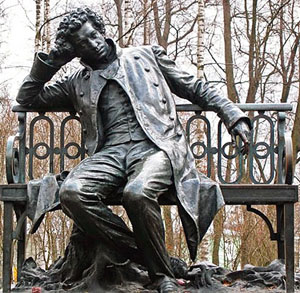 |
| A statue of Pushkin at Tsarkoe Selo, Russia |
Pushkin spent much of his adult life either in banishment or under house-arrest for his political views, which challenged the validity and competence of Russia’s Tsarist autocracy. Although the poet eventually reined in his polemic in trade for permission to publish (some of) his works, Eugene Onegin was, in many ways, a scathing commentary on Imperial Russia’s aristocracy and their social norms. As one Russian immigrant explained to me over a cup of tea last week: “The truth of Pushkin is in the verse, is in Onegin.”
The poem is told entirely through the viewpoint of a narrator, a thinly-veiled raisonneur of Pushkin himself. The Tatiana and Onegin of the poem are based on individuals from the poet’s life. Onegin is said to be fashioned after Pushkin’s friend Pyotr Chaadaev, and Tatiana after Chaadev’s friend Dunia Norova (both Chaadaev and Norova are mentioned in the original Russian verse). Lenski, the romantic young poet with lofty ideals, embodies many of Pushkin’s beliefs about truth, honesty and purity of art. Despite these real-life connections, Pushkin treats his characters with little sympathy: he despises Onegin for his cynicism, ridicules Lenski for his
naïveté, and bemoans Tatiana’s preoccupation with fictional romance. Pushkin explains their behavior as the inevitable fallout from being forced to abide by social conventions, which Pushkin viewed as stifling and destructive. Pushkin spent his early years in rebellion against the confines of his social sphere through copious consumption of booze, drugs and women. Yet he, too, eventually fell victim to the expectations of his society. For Pushkin, like Lenski, it proved fatal. |
| Nathalia Goncharova |
Pushkin and the Duel
Like Lenski, Pushkin died in a duel over the woman he loved. His wife, Nathalia Goncharova, was much like Eugene Onegin‘s Olga: a beautiful, rather simple-minded young woman who enjoyed living in high society and had no interest in Pushkin’s poetry. Besides driving up Pushkin’s debt and saddling him with the expense of her two unmarried sisters, Nathalia regularly roused his jealousy by flirting with her many admirers (including the Tsar). Pushkin was embarrassed and saddened by his wife’s behavior, Nathalia’s rumored relationship with Georges-Charles de Heeckeren d’Anthès finally forced Pushkin to act. On November 4, 1836, Pushkin and several of his friends received a “certificate” nominating Pushkin “Coadjutor of the International Order of Cuckolds.” Pushkin immediately accused d’Anthès of the insult and challenged him to a duel.
And here is where art and life truly intersect.
 |
| Georges-Charles de Heeckeren d’Anthès |
Pushkin’s desire to fight d’Anthès may well have been inflamed by the fate he had written for Lenski in Eugene Onegin. In the poem, Pushkin’s narrator predicts that Lenski’s marriage to Olga would have resulted in a wasted life, in which Lenski ceased being a poet and instead became a gouty, cuckolded landowner. Pushkin’s literary output had declined significantly over the course of his marriage, and by the time of the fatal duel he was producing almost nothing. He spent most of his time managing his family’s land-holdings while his wife gallivanted all over St. Petersburg.
Even as Pushkin fumed over the prospect that he was careening toward a socially respectable middle age, he might well have considered another parallel between his life and Eugene Onegin. In the poem, Tatiana has a terrifying dream in which Lenski, attempting to defend her honor, duels with Onegin. The poet is killed.
Whether or not Pushkin was affected by the possibility that he predicted the manner of his own death, he did not press the duel. He postponed it twice at his opponent’s request, and retracted his challenge altogether when d’Anthès proposed to one of Nathalia’s sisters (though Pushkin refused to attend the wedding or permit d’Anthès into his home). That might well have been the end of the story, save for d’Anthès continuing to pursue Nathalia in such a blatant fashion that Pushkin had no choice but to reissue his challenge. As in Eugene Onegin, social convention drove Pushkin’s behavior.
In the poem, there is a lapse of only a few days between Lenski’s challenge to Onegin and their dawn duel beside a picturesque mill. Nearly two months elapsed between Pushkin’s initial calling-out of d’Anthèd’Anthès. After Pushkin issued his challenge to d’Anthès, Nathalia made efforts to distance herself from the Frenchman despite his attempts to trap her into being alone with him.
Afterward
In the poem, Olga marries a soldier following an acceptable mourning period. Nathalia remarried six years after Pushkin died. In both cases, there is debate over whether these women loved their men. Scholars have argued for more than a century over Nathalia’s true feelings for her husband, one side blaming her vanity and selfishness for Pushkin’s death, the other conceding that she was vain but not so self-absorbed she couldn’t recognize Pushkin’s greatness. Whatever conclusions we might draw of her, it is worth noting that Nathalia preserved every letter Pushkin wrote to her during their tumultuous life together.




























0 comments on “Eugene Onegin: Art Imitates Life Imitates Art, Part I”